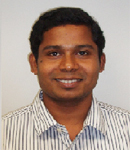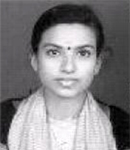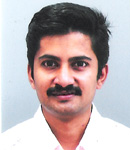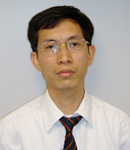|
|
| |
 |
Ding Zhibin |
Mr.Ding Zhibin,Research Area: Wind hazard mitigation.
Mr. Ding comes from People's Republic of China. He had attained his B.S. degree from Southeast University in China. In April 2006, he graduated and attained the M.S. degree from State Key Laboratory for Disaster Reduction in Civil Engineering of Tongji University, Shanghai, China, focusing on a systemic research on vortex-induced vibration and its control of free-standing bridge pylons, including wind tunnel experiment, CFD numerical simulation and theoretical formulation.
In April 2009 Mr. Ding became a PhD student in Wind Engineering Research Center in Tokyo Polytechnic University and joined the Globe COE Program as a research assistant. His research area is on the wind hazard mitigation. Unsteady aerodynamic force on structures in gust front is one of the important topics in the wind hazard mitigation field. Transient non-stationary extreme winds such as thunderstorm downbursts are responsible for significant structural damage and failures.
The transient non-stationary features of winds may markedly influence wind-structure interactions and wind load effects on structures. Over the past 40 years, extensive efforts have been made to understand and quantify stationary boundary layer wind effects on structures, and the methodologies developed have formed the basis for current wind loading codes and standards. However, the understanding of fundamental characteristics of those transient non-stationary wind effects on structures has yet to be developed. While, structures with long span usually have low stiffness and damping and will be more sensitive to the wind effect.
So Mr. Ding's PhD topic will focus on analysis of long span structure response to transient non-stationary winds and try to make some efforts to understanding the structure response to the transient winds. |
 |
Jiang Guoyi |
| From the year 2000 to 2006, I was studying in Beijing Institute of Technology (BIT) which is a famous university in China, obtained bachelor and master degree there on aerodynamics and founded an academic background in CFD. After graduating in July 2006, I joined the research group in wind engineering as an employee of China Academy of Building Research(CABR), and made an excellent research there. In April 2009, I went to Tokyo Polytechnic university(TPU) for my ph.D and GCOE program, under the recommendation of Prof. Jin , who is a famous scholar in wind engineering of China. Recent years, steady-state RANS CFD model is being increasingly used to the prediction of wind environment around buildings, and gets a good agreement with experiment for strong wind regions. But in weak wind regions behind buildings, the flow field is complex, sometimes has buoyancy effects, and the result is not satisfactory, so research of more accuracy CFD method using Large Eddy Simulation models is necessary. |
 |
Wonsul Kim |
Introduction of Current Study
Wind loads on tall buildings in a group in real environments can be quite different from those on an isolated building. Such surrounding buildings or downstream building(s) can significantly increase or decrease wind loads on building(s). This phenomenon has generally been called interference effect. The interference effect studies occurred in the early seventies. This sudden interest could perhaps be traced back to the collapse of three out of the eight natural draft cooling towers at Ferrybridge, England in 1965, which was attributed to interference effects.
Interference effects have been studied by many researchers over the past several decades. These studies have been carried out to try to codify wind loads caused by interference effects. In several limiting conditions, for example, one or two terrain conditions, several wind directions, and heights and sizes of one or two interfering buildings such as small, medium and large buildings, they produced not only a comprehensive database for purposes of codification by a huge number of wind tunnel experiments, but also a database produced by wind tunnel experiments that could provide empirical formulas for evaluating wind loads on adjacent buildings. Such a database and equations could be used for an approximate estimation of wind forces on a building under interference for preliminary design purposes. However, their studies to provide general recommendations have not been successful due to the complex nature of the problem and large variation such as the building geometries, relative locations of adjacent building(s), wind directions, upstream terrain conditions and so on. As well as, unfortunately most past studies have focused mainly on wind loads on the principal building for structural design. Therefore, it has studied interference effects for the largest maximum and the smallest minimum wind pressures on walls of two buildings by wind tunnel experiment to quantify cladding wind loads.
Self-Introduction
Present Position: Ph.D. Student of Tokyo Polytechnic University
Research Field: Wind Engineering, Structural Design
Qualification: Building Engineer License (No. 042041406541), South Korea
Email: kim@arch.t-kougei.ac.jp |
 |
Subramania Pillai Sivaraja |
QUALIFICATION:
PhD Student, Wind Engineering Research Center, Tokyo Polytechnic University, Atsugi,Japan (started on Sep 18th 2008)
M.Tech (Master of Technology), Chemical Engineering, A.C.College of Technology, Anna University, 2005-2007.
B.Tech (Bachelor of Technology), Chemical Engineering ,Kongu Engineering College, Bharathiyar University, 1999-2003.
Research Area
Wind Environmental Engineering
Heat Island Phenomena
Computational Fluid Dynamics
ReSEARCH TOPIC
Novel Wind Tunnel Technique for Heat Flux evaluation in Urban Canopy contributing to urban Heat Island and Mesoscale Meterology.
Heat Flux out of canyons in to the boundary layer is not understood clearly and so heat flux cannot be quantified.Quantifying the heat flux above the urban canopy with respect to change in the building dimensions was not studied .We are working towards the quantification of heat flux from urban canopy by a new wind tunnel experimentation technique.The change in Heat flux from Urabn Canopy with the change in the building dimensions were not yet investigated .The heat flux evaluation in urban canopy by wind tunnel experiment is one of the essential methodology for studying Urban Heat Island and mesoscale phenomena. The resulting heat fluxes from Urban canopy will be included in the Urban Canopy model for more precise Mesoscale modeling and prediction.
PERSONAL INFORMATIONS:
Father's Name : Mr.N.Subramania Pillai
Date of Birth : 06th December 1981
Nationality : Indian
Languages Known : Tamil, English, Japanese (learning) |
 |
Sudha Radhika |
Research Information: The research work focus on
(1)The ability of satellite and aerial images to identify the wind damages on residential buildings.
(2)Analysis of the wind damaged structures from satellite images using the latest cutting edge tools in pattern recognition.
(3)Relative ability of post disaster images alone compared to use of pre and post disaster images in identifying the wind disaster areas.
(4) Estimating the different resolutions of satellite images in identifying the wind damaged residential buildings.
(5)Automating the entire process for speedy identification of disaster areas enabling faster relief works.
Personal Information: Sudha Radhika (Married/Indian), M. Tech in Power Electronics, from Amrita University, India in the year 2007. Worked as a lecturer for 4 years in Engineering College in Kerala, India. Author of the International paper “Precise wavelet for current signature in 3phase IM” in Elsevier journal of Expert System with Application available online from May 22, 2009. Life Member of ISTE (Indian Society for Technical Education) and Member of AAWE (American Association for Wind Engineering). |
 |
Sabareesh G.R. |
Research Information:The research work focus on
(1)Design and development of a vortex flow generator to study the effect of Tornado-like flow on building models.
(2)Investigations on fluctuations of internal pressures and its characteristics as a tornado pass a building model.
(3)Effect of translational velocity of tornado –like flow on surface pressures acting on a building model.
(4)Effect of location of building models on its surface pressures when subjected to a tornado-like flow.
(5)Two international publications
G.R. Sabareesh, Masahiro Matsui, Akihito Yoshida, Yukio Tamura (2009), "Pressure Acting on a Cubic Model in Boundary-layer and Tornado-like Flow Fields", 11Americas Conference On Wind Engineering(11ACWE) at Puerto-Rico, San-Juan, America (to be presented on June22-26,2009)
Sabareesh. G.R, Yukio Tamura, Masahiro Matsui, Akihito Yoshida (2009), "Fluctuating pressures on cube faces and simulator floor in tornado-like flow", 5thEuropean Conference On Wind Engineering(EACWE) at Florence, Italy, Europe (to be presented on July 19-23,2009).
Personal Information:
Geetha Rajasekharan Sabareesh (Married/Indian), M. Tech in Engineering Design, from Amrita University, India in the year 2007. Worked as a lecturer for 4 years in Engineering College in Kerala, India. Author of two International papers “Precise wavelet for current signature in 3phase IM” in Elsevier journal of Expert System with Application available online from May 22, 2009, and “Fault Diagnostics of Roller Bearing using Kernel based Neighborhood Score Multi-Class Support Vector Machine”, in Elsevier journal of Expert System 36(3) with Application available online from July 18th, 2007. |
 |
Trung Vu Thanh |
Introduction of Current Study
Thermal reduction is always a problem for building roofing systems, especially profiled steel sheet systems, and roofing systems with the porous roof cover sheets have been applied to overcome it. In the major international codes and standards, e.g AIJ-RFLB (Architectural Institute of Japan 2004), ASCE 7-05 (ASCE 2006), AS/NZS 1170.2 (Australia/New Zealand Standard 2002) and Eurocode (2005), there is no provision for this structures. In literature, there are some studies on wind loading on the permeable roofing system through experiments (Kramer et al, 1979 and 1983; Kind and Wardlaw, 1982; Cheung and Melbourne, 1988; Amano et al, 1988; N. Chino et al, 1991; B. Bienkiewicz and Y. Sun, 1992 and 1997) but these studies focused on loose-laid roof-insulation systems (paving slab) or wind-permeable building facades. Unlike wind loading on building roofs, the wind loading on the porous roof cover sheet is a combination of wind pressures on both sheet surfaces. The current study is a new study on wind loading on porous roof cover sheets laid on top of a low-rise building subject to several effects such as porosity, parapet, underneath volume, ratio breath of building/ height of building (B/H), Reynolds number, terrain category and roof type for various wind angles and locations.
Self-Introduction
Present Position: Ph.D. Student of Tokyo Polytechnic University
Research Field: Wind Engineering, Structural Engineering
Qualification: Master of Engineering (2003), Vietnam
Email: trung@arch.t-kougei.ac.jp |
|
|
|









